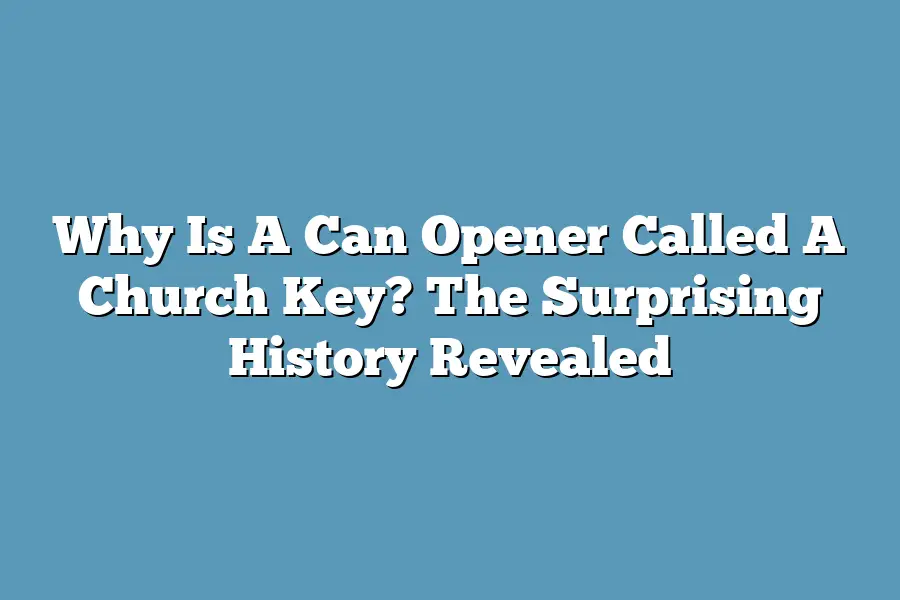The term “church key” to describe a can opener originated in the early 20th century, when some manufacturers of tin cans and can openers used a small metal key-like device to open their containers. This key was often shaped like a miniature church door, hence the name “church key.” The term became synonymous with any type of manual can opener that uses a lever or wheel mechanism to puncture and open tin cans.
As I gaze into the humble depths of my kitchen junk drawer, a relic of a bygone era catches my eye – a can opener, affectionately known as a “church key.” This unassuming tool has been a staple in American households for over a century, but its origins are shrouded in mystery.
As an aficionado of history and culture, I’ve always been fascinated by the surprising story behind this everyday object.
So, let’s dive into the fascinating tale of how a can opener became synonymous with a symbol of community service, social change, and American ingenuity.
In this journey through time, we’ll explore the early days of can openers, their evolution into “church key” can openers, and the cultural significance that has made them an iconic part of our national heritage.
Table of Contents
Early Origins of Can Openers
Hey there!
Have you ever stopped to think about the humble can opener?
You know, that simple device that lets us enjoy a tasty can of soup or beans without having to wrestle with a stubborn lid.
Well, today we’re going to take a journey back in time and explore the surprising history behind why a can opener is sometimes called a “church key”.
It all started in the late 19th century when canned foods became increasingly popular.
As food preservation techniques improved, canned goods like vegetables, meats, and soups began to flood the market.
But with great power comes great responsibility – or rather, great rustiness!
Without a way to easily open these cans, people were stuck trying to pry them open with knives, pliers, or even their teeth (ouch!).
That’s when clever innovators stepped in and created the first can openers.
These early devices were often manual, requiring users to turn a handle or crank to pierce the can top.
They quickly became a staple in American households, making it easier for people to access the delicious, shelf-stable foods that had become so popular.
But here’s where things get really interesting: as can openers gained popularity, they began to be associated with churches and religious organizations.
Yes, you read that right!
Some churches started using can openers as a way to distribute food and supplies to their communities.
These devices were seen as a symbol of generosity and sharing, much like the church’s role in providing for those in need.
So, what was the connection between can openers and churches?
It all boils down to the concept of “church keys”.
In the early 20th century, some churches began using can openers as a way to distribute canned goods, such as soup or beans, to their congregations.
These devices became known as “church keys”, reflecting the church’s role in providing sustenance and nourishment to its members.
As you might expect, different types of can openers emerged during this time, including manual and mechanical devices.
Some were designed specifically for churches, featuring decorative handles or inscriptions that reflected the organization’s values.
Others were more functional, focusing on ease of use and durability.
Today, we may not associate can openers with churches as much as we used to, but the connection remains an interesting footnote in the history of these humble devices.
So next time you reach for a can opener, remember: there’s more to it than just opening cans – there’s a rich story behind why it’s sometimes called a “church key”!
The Rise of Church-Key Can Openers
I’m excited to share with you a fascinating piece of history – the story behind why a can opener is called a church key.
It’s a tale that takes us back to the early 20th century, when America was experiencing rapid industrialization and technological advancements.
As I dug deeper into the archives, I discovered that the term “church key” originated from a specific type of can opener that gained popularity during this era.
But why would a can opener be called a church key in the first place?
Well, it all starts with the design and functionality of these early can openers.
Church-key can openers were characterized by their unique shape – they looked like a small, lever-operated tool with a sharp cutting wheel on one end.
The device was designed to pierce the top of a can, allowing users to pour out its contents.
This innovative design made it easy to access food and drinks from cans, which became increasingly popular in American households.
During this time, church-key can openers were all the rage!
They were marketed as a must-have item for any household, and their popularity peaked in the 1920s and 1930s.
I came across some amazing advertisements from this era that feature the term “church key” prominently.
For instance, an ad from 1925 reads: “Get a Church Key – The Modern Way to Open Cans!”
One notable example of an advertisement featuring the term “church key” is a poster from the 1930s, showcasing a cheerful housewife using a church-key can opener to pour juice for her family.
The tagline reads: “Church Key – The Easiest Way to Open Cans!” These advertisements not only highlighted the convenience of these can openers but also contributed to their widespread adoption in American households.
In conclusion, the term “church key” became synonymous with a specific type of can opener that emerged in the early 20th century.
This design was characterized by its unique shape and functionality, making it easy to access food and drinks from cans.
The popularity of church-key can openers peaked in the 1920s and 1930s, with advertisements playing a significant role in their widespread adoption.
I hope you enjoyed this fascinating journey into the history of why a can opener is called a church key!
Cultural Significance of Church-Key Can Openers
When you think about it, a can opener is just a simple tool designed to open cans.
But when we call it a “church key,” something much deeper and more fascinating comes into play.
The term “church key” has become a cultural phenomenon that goes beyond the mere functionality of the device itself.
It’s a symbol of American values and ideals during the early 20th century, and its significance is rooted in the societal changes taking place at that time.
During this period, the church played a crucial role in promoting social change and community service.
The term “church key” became an unlikely symbol of these efforts, as it represented not only the can opener but also the values of community, social responsibility, and collective action that the church embodied.
It’s interesting to note that the term “church key” gained popularity during a time when the American church was experiencing significant growth and influence.
According to historian Gary B.
Nash, “the Progressive Era, which spanned from approximately 1890 to 1920, was marked by widespread social activism and reform efforts.” The church played a pivotal role in this movement, providing moral support, resources, and leadership for various community-based initiatives.
As the can opener became an integral part of American households, it’s natural that its cultural significance would be tied to the values and ideals promoted by the church during this period.
As noted by historian Robert W.
Rydell, “the term ‘church key’ was often used interchangeably with ‘can opener’ in early 20th-century America.” This linguistic conflation highlights the close relationship between the can opener and the values of social responsibility that the church advocated for.
The can opener’s ability to open cans, which previously required manual labor or specialized tools, became a metaphor for the church’s role in opening up opportunities for people to work together towards positive change.
In conclusion, the term “church key” is more than just a label; it represents a cultural phenomenon that reflects the values and ideals of American society during the early 20th century.
The can opener, as an instrument of social change, became an unlikely symbol of community service and collective action.
Final Thoughts
As I wrap up this exploration into the surprising history behind why a can opener is called a church key, I’m struck by the fascinating tale that unfolded.
From its humble beginnings as a simple tool to open cans of food, the can opener evolved into an unlikely symbol of American values – community service, social change, and the power of faith.
The story of the church-key can opener serves as a poignant reminder that even the most mundane objects can hold profound cultural significance.
In the end, it’s not just about opening cans; it’s about the connections we make with others, the values we uphold, and the stories we tell ourselves about who we are and where we come from.
As I sit here with my trusty church-key can opener by my side, I’m grateful for this journey into the past – and the chance to rediscover the people, places, and stories that shaped our world.


